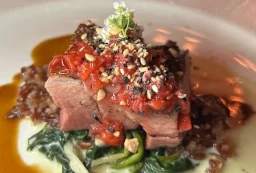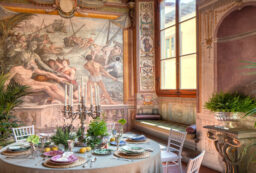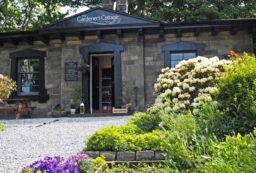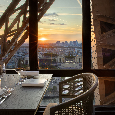
It is said that only Allah can create perfection but a hands-on course with the Fez Cooking School at the heavenly Palais Amani, not only takes your Moroccan culinary skills to new levels it also lifts the tajine lid on Moroccan life.
Our chef, Zakia, with our guide Fatima, lead us into the ancient Medina. It is a UNESCO heritage site where we shop for our ingredients and taste the flavours of Fez life. In this maze baked by a North African sun, “khill’i” – knowing how to preserve food before the days of cling-film, fridges and sell-by dates – was an essential survival skill.

It is a labyrinthine Medieval world of perhaps 9,500 alleys with countless dead ends. A maze of narrow twisting passageways impossible to map on paper and beyond GPS.
“Balek!” Translating as “Look out” this is one of the cries as an overladen handcart delivers tumbling carrots and turnips to a stall. Fassi is the local Arab dialect here but Arab visitors will recognise the “Salams”, the greetings of the 60,000 people who live within the Medina as they go about their daily routines. If it were not for electricity, mobile phones and football shirts we could be walking through the Middle Ages.

"“My compliments to the chef,” says one graduate of the Fez Cooking School as he tucks into his chicken tajine."
From sheer practicality this is the world’s largest pedestrianised space. There are no choices. Donkeys, men and mules are the beasts of burden. Hand carts are the very latest technology. Literally follow your nose to navigate: sniff out the fish souk, the spices souk, the bakery souk, the tannery for leather goods and the aroma of mint tea. Or keep your eyes on Fatima and Zakia to avoid getting lost.

As a chicken tajine is our final goal we stop at a stall of live chickens. Fatima pre-empts our objections, “My grandmother always asks why should she buy a dead chicken? She does not know when it was killed.” Fortunately, for our genteel First World sensibilities, our chicken had met its maker the day before and marinated overnight in lemon juice and salt, to reduce bitterness.

During the morning, locals call into stalls that are open just for breakfast. Five dirham buys a bowl of garlicky soup and a hunk of flatbread. Another popular stop is for sfinjat. Think donuts fried in an oil spiced with cumin and salt and then coated, at the last moment, with an egg. As we cluster around a small table, Zakia, born in Fez, tells us of her childhood memories and how her grandmother taught her to cook. She loved fish, a luxury, as it travelled four hours from the coasts. Significantly the Quran never once uses the word “fish” as it’s original writers were a desert people.

Zakia guides us to stalls where women knead dough and bake it. Old men look on disapprovingly. For them, this is the easy, lazy modern way. Traditionally, women kneaded the dough in their own kitchens. Then another member of the family took the loaves to a baker. Food can be a means of preserving the old ways. If you take the bread and pastry-making course at the Palais Amani you will walk your loaves to the communal baker. There are no names, no labels on the tins.The baker knows every tray be sight.
Then Zakia buys spices – cumin, ginger, turmeric, coriander and a little chilli – for our tajine. We stroll on through alleys, some partially sheltered from the sun by cedar lattices, casting geometric shadows. Above other alleys, sun-bleached strands of fraying sugar-cane provide dark pools of shade.

For half a century Atay Bnaanaa, with a flamboyant cerise headdress topping a walnut creased complexion, has been pouring mint tea. His blue-tiled tea room is far too small to even park a camel. First, he brews plenty of sugar with a smattering of Chinese tea, in a copper samovar. Then he pours the liquid, adding leaves of absinthe, geranium, verbena, sage and plenty of mint. At ten dirham per cup this is the Bollinger of mint teas: a winter warmer and a summer refresher.
We stop at a sweet stall. Food does not just reflect society it is the structure of belief and life. During Ramadan, when no food must pass the lips between sunrise and sunset, sweet pastries – packed with energy giving calories – are the last and first food people eat. But why do Arabs have such a sweet tooth? Traditionally, parents squeezed sweet date juice onto a child’s gums at birth.

Time to return to the Cookery School on the top level of the Palais Amani, a grand 17th century palace, restored with Art Deco flourishes after the earthquake of 1928. Amongst the olive trees, bougainvillea, vines and roses of this rooftop garden we are to cook our lunch.

A chicken tajine accompanied by a side-dish of Zaalouk. “That smoked aubergine purée is my twenty-something son’s favourite seduction dish,” says Jemima Mann-Baha, an English woman, who with her Fez husband, Abdel, had purchased a very tired looking Palais in 2006. After they had restored the Palais, they created the Fez Cook

Dessert can only be described as “Fez Mess”, a concoction that replaces Eton’s meringue with fried flatbread and adds orange blossom water to the cream.
After we’ve slaved away over our tajines, following Zakia and Fatima’s instructions, it’s time to take our lunch. We opt to eat at The Eden Restaurant down in the gardens of citrus trees and by the cooling water feature.

“My compliments to the chef,” says one graduate of the Fez Cooking School as he tucks into his chicken tajine. Enthused by Moroccan cuisine, he flicks through the vast cookery book “Feast: Food of the Islamic World” by Annisa Helou, who had officially opened the Fez Cooking School. A tour of the Fez Medina opens your mind to a world of culinary opportunities.
















